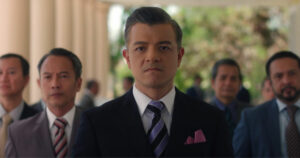Movie Review
Quezon
Directed by Jerrold Tarog
By Brontë H. Lacsamana, Reporter
TO DEEPEN the deconstruction of the national hero, TBA Studios and director Jerrold Tarog’s Bayaniverse series have turned their attention to Manuel L. Quezon. Set in the American occupation, Quezon depicts the political squabbles and brutal manipulation that its titular figure must resort to in order to attain independence for the Philippines.
Played with magnetic force by Jericho Rosales, the Manuel L. Quezon we see here is a ringleader of the circus known as Philippine politics, its familiar shape still ringing true to what we experience today.
The rest of the characters are chess pieces to him — from Governor Leonard Wood (an amusing appearance by Game of Thrones actor Iain Glen), Sergio Osmeña (an entertaining supporting role brought to life by Romnick Sarmenta), journalist Joven Hernando (a supposedly enlightened stand-in for the audience played by Cris Villanueva), or sympathetic antagonist Emilio Aguinaldo (with which Mon Confiado continues to steal scenes).
Coming from the unbridled fury of Heneral Luna and the reflective nature of Goyo, this installment in the series takes us to the performance of nation-building, set not in battlefields but at podiums and facing cameras. Quezon, as the third larger-than-life figure in the Bayaniverse (a portmanteau of bayani or hero and universe), enjoys high production values as well, even if the centerpieces are explosive conversations and political machinations rather than fight scenes. Philippine history is interpreted through the lens of the journalist Joven character, who has a front seat to Luna*, Goyo**, and Quezon’s biggest successes and failures.
What this set of films does is expose the folly in the notion of a hero who will save the Philippines from itself. In Quezon, it in fact proposes that the very hero being revered may be the catalyst for the worst of our country’s flaws.
Rosales as Quezon is a spectacle, with his high-pitched Tagalog-accented voice that mimics the gravitas of a transatlantic declamatory statesman. It matches, too, with the crux of his character being that of a man who learned from the Americans’ game of politics, and brought it back home. His performance and chemistry with the rest of the cast (namely his toxic push-and-pull with Sarmenta’s Osmeña and his dogged face-off with Confiado’s Aguinaldo) make a strong case for this film being the most entertaining of the three.
Unfortunately, it may also be the one with the least heart in it. The senseless politicking and pandering to the promise of independence (at any cost) includes a pessimistic, self-referential plot point for the journalist character and his filmmaker daughter. The two fall prey to making propaganda for Quezon but ultimately can’t make any definitive, concrete stand. It succeeds at holding up a mirror to the audience members watching, who decry corruption and bad governance, but cannot suggest or invoke any alternative. It’s true, yes, but it could be much more.
Quezon is a strong biopic and historical drama that satirizes politics through sensational slapstick moments starring some of the Philippines’ best known figures from the American period. For a dialogue-heavy film, it’s thrilling to follow thanks to its playful structure, making it stand out from its two predecessors which were mainly linear and battle-focused. It is a film with a deeply cynical take on a nation’s coming-of-age. There is also the questioning of the truth behind the murders of Andres Bonifacio and Antonio Luna, putting to the test our belief in historical narratives.
What it didn’t really account for was the impact of Quezon’s actions. It only focused on the political spectacle that worsens the state of the nation and makes the dream of independence unreachable, even laughable. There’s a small scene where a farmer reveals that most people don’t understand what independence means. The film doesn’t explore beyond that — how the Filipino politicians and the American occupiers take advantage of this ignorance, what the average Filipino’s life is like, and why independence is such a pipe dream. Perhaps there we could have found the film’s heart.
* Antonio Luna, who led the Philippine Republican Army during the early phases of the Philippine-American War. The first film in the Bayaniverse, Heneral Luna (2015), picks up just at the end of the Philippine Revolution against Spain and covers the machinations of the central figures in the aborted first republic and provincial rivalries, including the first Philippine President Emilio Aguinaldo, Felipe Buencamino, Pedro Paterno, Pedro Janolino, and Luna, ending with the assassination of Luna and his aides-de-camp. Gregorio del Pilar, the subject of the second film in the Bayaniverse, makes an appearance in the middle of the film.
** Gregorio del Pilar or the “Boy General” of the Philippine-American War. The second film in the Bayaniverse, Goyo: Ang Batang Heneral (2018), tackles his rise right after Luna’s assassination, to his death at the Battle of Tirad Pass against the Americans, and sets up the appearance of Quezon who is the subject of the third film.

